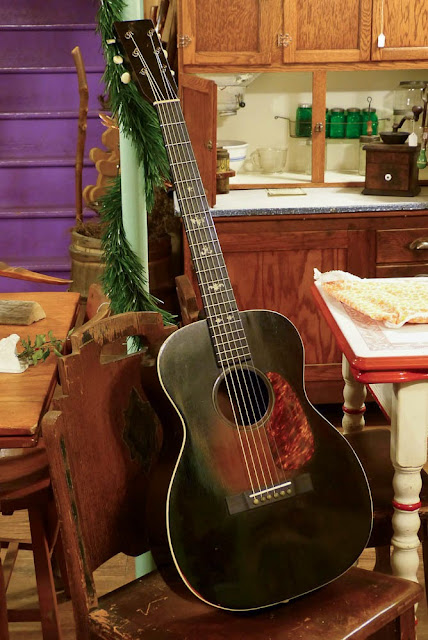c.1935 Harmony "Vogue" Model B Guitar
Update: I forgot to mention that this comes with a chip case.
In the mid-30s, Harmony introduced their "Vogue" line of modern-ish (for the time) instruments targeted towards the aspiring player probably moving up from student gear. They're no-frills in terms of style but the designs are catchy with typically sunburst finishes, gloss coats, and body styles aping popular models by other makes. This "model B" flattop guitar is almost a direct rip in form of a Martin 00-size 14-fret guitar save it's sunburst like a Gibson-style instrument and features that typical light, Harmony-style ladder bracing and a 1 3/4" nut, big old v-neck.
My work on it included a neck reset, fretboard extension reglue/reseat, replacement bridge (I like to get rid of the original ones on Harmony products from the time as they tend to be brittle, fragile dyed maple or birch), new bone saddle, fret level/dress and setup. Due to the very light bracing (as typical for 30s Harmony flattops) I've strung it with a set of extra lights (46w-10) for standard tuning. The player could probably get away with 11s especially if he or she slacks the strings for open tunings, but I play it safe with this era of Harmony flattop -- 12s would deflect that top and jack action up over time.
That said, this guy plays nicely (spot on 3/32" bass, 1/16" treble at the 12th fret) and is an ideal instrument for a fingerpicker. It also has a good mid-focused, round and rich sound for a strummer that prefers a medium or lighter pick.
Amazingly, the guitar is crack free except for a 1/4" tiny hairline at the top edge of the soundhole (only to the rosette) that happens to be stable. The finish also polished back up nice and glossy (these were marketed as snazzy high-gloss instruments), though it does show scuffs and scratches here and there from years of use.
The top is solid spruce while the back and sides are solid birch. The neck is most likely a big hunk of poplar. The fretboard is dyed/ebonized maple.
This guit spent most of its life as a raised-nut "Hawaiian" instrument and the brass frets were nearly untouched. Still, they needed a leveling/dressing due to wood shrink of slight amounts over time. The neck is dead straight.
Note the chip-out at the 12th fret! Because the fretboards on these were dyed/ebonized material, they get pretty brittle over time. When I reglued the fretboard extension down after the neck reset, some o the wood chipped out and splintered into a zillion pieces (par for the course on this era of Harmony dyed board) so I drop-filled the chipped areas a little bit. It just doesn't match well (how does one go about recreating that hazy aged-grey color?)...
The characteristic Vogue decal is missing (though its footprint is still there). The nut is 1 3/4" in width and bone. The scale on this guy is 25 1/4" which means you get a lot of power out of even this quite light set of strings. It's a loud guitar!
Simple rosette with tortoise celluloid glued-on pickguard. It's come up at a couple edges but I snuck glue under it enough to hold it well and keep it from buzzing on the top.
My replacement bridge uses the original discolored bridge pins and is almost exactly the same size as the original (but better quality). The original was coming up anyhow.
The cream top binding and blackened back and sides recall Kalamazoo-branded Gibson products.
The brass-plate tuners work just fine now that they're lubed.
What's nice about this body size is that it fits beautifully in the lap and unlike a 14-fret 0 guitar, the 00-size (14 1/2" lower bout) gives this more warmth and presence.
Everything but the bridge and saddle is original equipment... including this endpin.
You can see the bit of wear to the finish here near the heel.















Comments